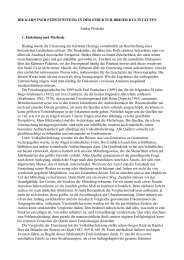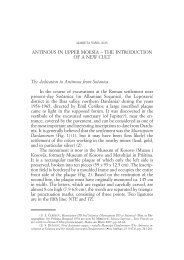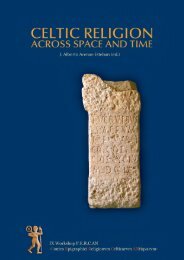The Roman conquest of Dalmatia and Pannonia under Augustus
The Roman conquest of Dalmatia and Pannonia under Augustus
The Roman conquest of Dalmatia and Pannonia under Augustus
You also want an ePaper? Increase the reach of your titles
YUMPU automatically turns print PDFs into web optimized ePapers that Google loves.
110 Šašel Kos, <strong>The</strong> <strong>Roman</strong> <strong>conquest</strong> <strong>of</strong> <strong>Dalmatia</strong> <strong>and</strong> <strong>Pannonia</strong> <strong>under</strong> <strong>Augustus</strong><br />
course <strong>of</strong> Octavian’s actions, which were to a large<br />
extent also diplomatic, it would not be impossible<br />
that a detachment <strong>of</strong> Octavian’s army might have<br />
reached the Danube, as he is said to have expressly<br />
claimed before the battle at Actium. 27 In this context,<br />
we should most probably <strong>under</strong>st<strong>and</strong> “the Danube”<br />
to mean the river’s course near Sirmium.<br />
In his Res gestae, <strong>Augustus</strong> was most probably<br />
referring to the <strong>Pannonia</strong>n peoples, <strong>of</strong> which the<br />
Andizetes are known to have been the northernmost,<br />
<strong>and</strong> not to the Celtic population <strong>of</strong> the later<br />
<strong>Pannonia</strong>, living north <strong>of</strong> the Dravus River. 28 Some<br />
<strong>of</strong> these Celtic peoples may have been more or less<br />
dependent on the Norican kingdom <strong>and</strong> consequently<br />
not hostile to the <strong>Roman</strong>s; most <strong>of</strong> their<br />
regions may have been peacefully annexed. <strong>The</strong><br />
<strong>Roman</strong> frontier in <strong>Pannonia</strong> shifted along with new<br />
<strong>conquest</strong>s, <strong>and</strong> it may well be that the entire course<br />
<strong>of</strong> the Danube was not fi rmly in <strong>Roman</strong> h<strong>and</strong>s<br />
before Claudius. Stages in the limes development<br />
no doubt existed: fi rst <strong>of</strong> all, a strong military line<br />
along the upper Sava River would certainly have<br />
been very important in order to capture Segesta/<br />
Siscia <strong>and</strong> annex its territory. <strong>The</strong> lower course <strong>of</strong><br />
the river, as well as the Drava <strong>and</strong> most <strong>of</strong> the Danube,<br />
had not been conquered before the <strong>conquest</strong>s<br />
<strong>of</strong> Tiberius. <strong>The</strong> legionary camp at Siscia, dating<br />
back to Octavian, 29 was much earlier than those at<br />
Poetovio <strong>and</strong> Sirmium. 30<br />
<strong>The</strong> <strong>Pannonia</strong>n-<strong>Dalmatia</strong>n Rebellion<br />
However, war preparations against Maroboduus, particularly<br />
the recruitment <strong>of</strong> soldiers, triggered the outbreak<br />
<strong>of</strong> the rebellion in Illyricum (Fig. 3), towards<br />
the end <strong>of</strong> which the large area with fi ve legions was<br />
divided into an upper (<strong>Dalmatia</strong>) <strong>and</strong> a lower (<strong>Pannonia</strong>)<br />
province. 31 According to Velleius Paterculus,<br />
who himself took part in the war, bringing new<br />
recruits from Rome to Tiberius, the collective number<br />
<strong>of</strong> rebels would have amounted to 800,000, including<br />
200,000 infantrymen <strong>and</strong> 9000 cavalry. 32 Expe-<br />
27<br />
Cassius Dio 50. 24. 4; ŠAŠEL KOS, ib.<br />
28<br />
FITZ 1998; id. 1993, 13–14.<br />
29<br />
RADMAN-LIVAJA 2007, 161 ff.<br />
30<br />
Poetovio: some time after 15 BC, see HORVAT et al. 2003,<br />
156; Sirmium: a <strong>Roman</strong> stronghold attested in AD 6: MIRKOVIĆ<br />
2004, 147.<br />
31<br />
KOVÁÁCS 2008, with earlier literature; ŠAŠEL KOS 2010.<br />
32<br />
Velleius 2. 110. 3. Appian, however, noted that there had<br />
been a total <strong>of</strong> 100,000 men capable <strong>of</strong> fi ghting among the <strong>Pannonia</strong>ns<br />
at the time <strong>of</strong> Octavian’s Illyrian war (Appian Illyr. 22.<br />
63). This is closer to reality, cf. also DŽINO 2006.<br />
rienced comm<strong>and</strong>ers <strong>of</strong> this army planned – with<br />
part <strong>of</strong> it – to attack Italy, which was connected to<br />
their territory by the border areas <strong>of</strong> Nauportus <strong>and</strong><br />
Tergeste; part <strong>of</strong> the army would invade Macedonia,<br />
while the third part was intended to defend<br />
their own territories. 33 <strong>The</strong>ir leaders, both Batos<br />
<strong>and</strong> Pinnes, enjoyed great authority; the army was<br />
disciplined – some even knew Latin <strong>and</strong> were<br />
acquainted with <strong>Roman</strong> culture. 34 <strong>The</strong>y attacked<br />
<strong>Roman</strong> citizens, killing merchants <strong>and</strong> many veterans,<br />
who were settled at some distance from the<br />
<strong>Roman</strong> garrisons. <strong>The</strong>y occupied (parts <strong>of</strong>) Macedonia,<br />
causing great damage everywhere. 35<br />
Velleius fi rst mentioned the victory <strong>of</strong> M. Valerius<br />
Messalla Messallinus, praepositus <strong>of</strong> Illyricum,<br />
who had been trapped by the enemy with half <strong>of</strong> the<br />
20 th legion. Next he narrated the battles near Mons<br />
Claudius (Požeška brda [Požeška Hills], northeast<br />
<strong>of</strong> Siscia), occupied by the rebels, who almost<br />
defeated the army brought from the transmarine<br />
provinces by A. Caecina Severus <strong>and</strong> M. Plautius<br />
Silvanus. This army consisted <strong>of</strong> fi ve legions with<br />
auxiliary soldiers, accompanied by a detachment <strong>of</strong><br />
horsemen <strong>under</strong> the Thracian king Rhoemetalces.<br />
For a short time, the entire army was stationed in<br />
one camp at Siscia, composed <strong>of</strong> ten legions, more<br />
than seventy cohorts, ten alae, <strong>and</strong> over ten thous<strong>and</strong><br />
veterans. Since it was impossible to control<br />
such a huge force, however, Tiberius accompanied<br />
the new legions back to their provinces, returning<br />
to Siscia at the beginning <strong>of</strong> the winter. <strong>The</strong> next<br />
summer, <strong>Pannonia</strong> capitulated <strong>and</strong> the rebels deposited<br />
their arms at the Bathinus River (the Bosna).<br />
Comm<strong>and</strong> over the army in the winter camp at Siscia<br />
was given to M. Aemilius Lepidus. 36<br />
At the beginning <strong>of</strong> the summer <strong>of</strong> AD 9, Lepidus<br />
set <strong>of</strong>f to join Tiberius in <strong>Dalmatia</strong>, traversing<br />
regions as yet untouched by the war, where he had<br />
to fi ght the enemy on all sides. Germanicus <strong>and</strong> C.<br />
Vibius Postumus, praepositus <strong>of</strong> <strong>Dalmatia</strong>, also<br />
successfully fought in the <strong>Dalmatia</strong>n part <strong>of</strong> Illyricum.<br />
That summer saw the end <strong>of</strong> the war, with the<br />
Perustae, Desidiates <strong>and</strong> the Delmatae decisively<br />
33<br />
DZINo 2010, 147 refuses to give credit to this plan, which,<br />
however, is partly confi rmed by subsequent <strong>Roman</strong> strategy<br />
<strong>and</strong> actions, <strong>and</strong> indirectly also by the account <strong>of</strong> Cassius Dio<br />
(see infra).<br />
34<br />
Velleius 2. 110. 5: Velleius‘ optimistic remark could have<br />
referred to a few only, cf. ALFÖLDY 1995, 26.<br />
35<br />
Velleius 2. 110.<br />
36<br />
Velleius 2. 111-114; commentary in RADMAN-LIVAJA / DIZ-<br />
DAR 2010; some aspects in Džino 2009.










